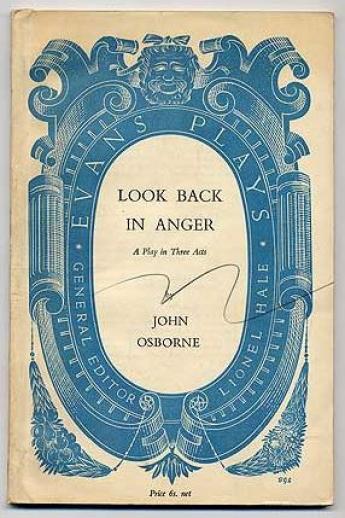Antiquarian Booksellers' Association of America Lighthouse Books, ABAA
Collecting Rare Books and First Editions - John Osborne wrote Look Back in Anger

By Michael Slicker
John Osborne’s play Look Back in Anger (1956) is credited with transforming British theater from escapist fantasies to stark realism. The play came to represent a generation of disaffected Brits after World War II and was hailed as a significant theatrical breakthrough. Osborne was described as the first of the "angry young men," working class British playwrights and novelists who came to prominence in the 1950s. The play was adapted for a 1959 film starring Richard Burton, Claire Bloom, and Mary Ure (whom Osborne married). It was directed by Tony Richardson.
The play had an inauspicious beginning. Osborne was working in a tiny theater company in a resort town in northern England. He wrote the play in 17 days while sitting a deck chair on a pier recalling earlier acrimonious days with his actress wife in their cramped living quarters in a small town in central England. They fought and argued, and all the while she was having an affair with a local dentist. The play was full of vitriol and pessimism, and included tirades on the mediocrity of middle-class British life.
When he returned to London, Osborne submitted the play to numerous agents but it was returned, (remarkably quickly, Osborne thought, though he wasn't surprised at the rejections.) Finally, he sent it to a new theater group, English Stage Company at London's Royal Court Theatre. The company had had three flops in a row and desperately needed a hit. Osborne was pretty desperate himself. At the time he was living in a leaky houseboat on the Thames River with an actor friend. They had little money. They gathered plants from the river bank and cooked them to eat.
At first, the play received negative reviews, with critics calling it a failure and "a self-pitying snivel." But then the most influential critic of the time, Kenneth Tynan, called it the best young play of the decade. Audiences took notice, and the play became a commercial success. It eventually played in London's prestigious West End and Broadway. During the original production, Osborne began a relationship with Mary Ure, who was in the cast, and divorced his wife, actress Pamela Lane.
Osborne followed the success of Look Back in Anger with The Entertainer (1957), which used the transition from vaudeville to rock 'n roll as a metaphor for the British Empire's decline in world stature. It starred Laurence Olivier, who also did a movie version two years later. Osborne also wrote Luther (1961), a study of the life of Martin Luther, and the screenplay for Tom Jones (1963), the film adaptation of Henry Fielding's 1749 novel.
***
Posted on the Lighthouse Books Blog, presented here by permission of the author. Picture: Between the Covers Rare Books.
